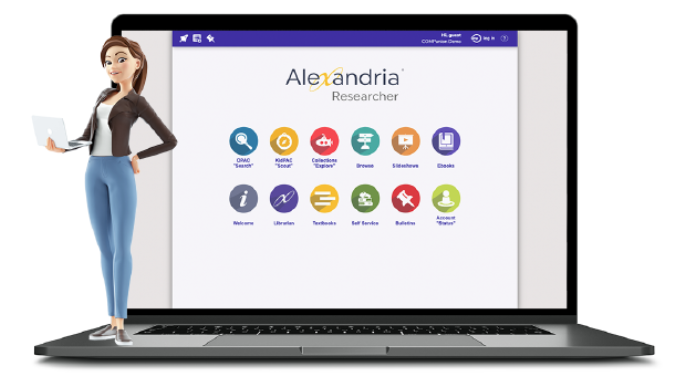Best Practices for First-Time Librarians

Librarians wear a lot of hats! You have to keep the library organized and updated, teach students how to use the library for fun and learning, and make the most out of Alexandria. We’re here to help!
Handle overdue and lost books with grace
Review Policies to set loaned item periods, overdue fines, and grace periods. When deciding on whether or not to charge fines, or how you want to follow up on overdue or lost books, consider your patrons and the relationships that you have with them. You may decide to remove overdue fines and set up more soft overdue notices.
Collaborate and communicate
Librarians love working with others—librarians, teachers, building committees, curriculum leaders, parent organizations. Alexandria has tools that can help you. Learn about Bulletin Boards, Email Notifications, and Patron Alert Notes.
Slideshows on topics that relate to curriculum—even on a moment’s notice—can be coded and emailed as a loop to be shared in multiple classrooms.
Create Explore Panes for Citation Resources and helpful sites, including databases to best support teachers who are working on Essay Writing.
Help your teachers set up Bulletin Boards for specific topics or classes, or even book clubs and writing activities. Take online offerings and turn them into engaging bulletins that can be shared districtwide. Link to book trailers and articles, and even include Google Forms for assessment or to gamify learning.
Make your library the most accessible
Librarians create a welcoming gathering place filled with comfort, safety, and cozy furniture for patrons. They carefully curate the library catalog and even read books in order to decide if they are going to add them to the library. When it comes to Alexandria, you can do a few things to make it more ‘comfortable’ for patrons of different levels and abilities.
- Set up Researcher; add an Ask-A-Librarian button on your Researcher page that links to a Google Form to further assist patrons as a virtual reference service.
- Accessibility tips, set up Maps, using Scout for younger patrons—and teaching patrons which Search/Browse/Explore to use for what purpose.
- Keep the collection up-to-date; use Super Summary and Weeding List by Title to make room for new, exciting, and useful materials.
- Use Search Strings (short smart codes) to create dynamic book experiences for readers, multiple ways to search for books, and build out book club challenges, first chapter challengers, and voice and choice lessons that can be shared districtwide—all without the need to select books individually or build out a program. All this, without necessarily needing to reorganize your shelves.
Set up rules for reordering and cataloging
Set barcode ranges with specific vendors.
Make instructions for yourself and other catalogers on how to catalog and label books.
Use tools to inspire readers and cultivate curiosity
- Share Slideshows. Librarians are first great and avid readers! They find the books they love, order the best of the best, and give them out to be read and read and read onward until their life on the shelf ends and minds and hearts have been touched forever. Share the books you love with a Slideshow—but don’t stop there! Compile a whole set, and have them at the ready for any aged reader at any given moment.
- Build Bulletin Boards. Build book experiences in your library that enhance the physical space AND extend out to the community virtually. Create a first page bulletin. Build a Book Club event. Share a Themed Stories Bulletin and email it home or send it to all teachers using a single URL.
- Create Endless Explore Panes. In Alexandria, explore panes are a great way to help patrons interact with your library in new ways. Create panes to share books by Lexile levels or AR levels, or share teacher guides or series titles or videos or coding activities or online games and more!
- Link to More. Use the Other tab in Items Management to expand book experiences. Link to a video or trailer or reading or game the author shares online or link to the author’s website—or, if you’re an AR school, link to a quiz.
- Try TeachingBooks and NoveList.
Bring balance to your day
As much as you might wish to, you can’t do everything! Identify the most important and urgent tasks so you can complete those first, and then move on.
- When you can, find ways to delegate and collaborate. Students love to help out in the library.
- Self-service stations – Self-service stations streamline efficiencies, reducing waiting times for users. Instead of waiting in line to check out a book or return materials, users can simply scan their library card and complete the transaction themselves. This not only saves time for users but also allows librarians to focus on other important tasks, such as assisting with research or providing recommendations.
- Use the technology that you have to streamline and automate certain tasks (scheduled reports for overdue items, loaned items).
- Use an SIS integration, online services package, and automatic imports.
Build your own confidence
Attend workshops, conferences, and webinars to enhance your skills and help you gain new knowledge. Connect with fellow librarians, public and online, to share experiences, seek advice, and collaborate with peers. Find a mentor within the library field who can offer guidance and support. Embrace digital resources and learn how to adapt new technologies for your library and your patrons.

0 Comments